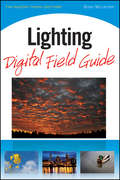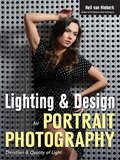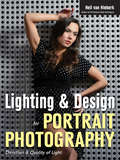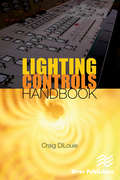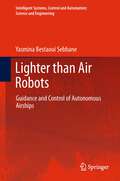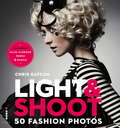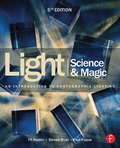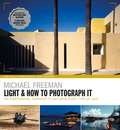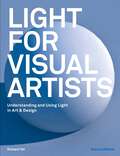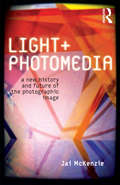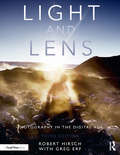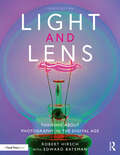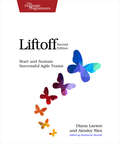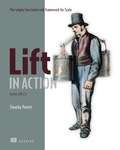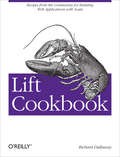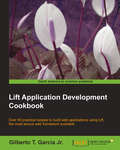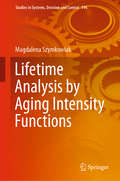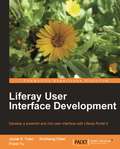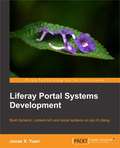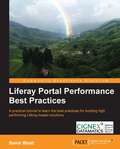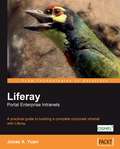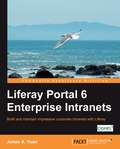- Table View
- List View
Lighting Digital Field Guide
by Brian MclernonEssential lighting guide for users of compact cameras and dSLRsOne of the most important aspects of photography is lighting, but getting the lighting right is tricky. When should you use flash? Are a camera's automatic settings dependable? Should you use reflectors or diffusers and where do you place them? This handy, portable reference will show you when, where, and how to create and capture perfect light, every time. The book includes a color checker card to help you maintain true color, as well as examples of stunningly-lit photos of people, wildlife, and landscapes to inspire you.Walks you through the essentials of lighting for digital photographyHelps beginning and intermediate photographers leave the safety of automatic settings and confidently control lighting themselvesShows how to evaluate natural light, decide when to use flash, and how and when to use diffusers or reflectorsIncludes a tear-out color checker card to help you maintain true color in your photographsComes in the handy, portable Digital Field Guides size, perfect for camera bagsCreate and capture the perfect lighting every time, with Lighting Digital Field Guide!
Lighting & Design for Portrait Photography
by Neil Van NiekerkSome photographers make portraits that we can’t take our eyes off of. These images create mood, evoke emotion, and pique our curiosity. They have that certain something that other portraits seem to lack. These rare images are memorable-the kind of shots that clients want and photographers strive to emulate. These portraits are technically precise and have style. Neil van Niekerk is a big name in the portrait and wedding photography industry. His masterful photographs get a reaction, and he’s devoted to helping others create compelling portraits for their clients. In this book, van Niekerk shows readers strategies for creating a wide range of portrait looks (romantic, fun, sweet, dramatic, glamorous, or moody) in lackluster, middle-of-nowhere locales, small home studios, big expanses, and even on rooftops. Starting with traditional lighting and posing strategies and moving through "spicier” varieties, he shows readers how integrating specialized lighting (rim lighting, backlighting, flare, and low-key lighting-using natural light and artificial sources) and compositional approaches (shallow depth of field, lens compression, and unorthodox perspectives) into their creative approach can allow them to take full creative control over their portrait-taking process so that they’re able to deliver incredible shots of their clients in any photographic conditions.
Lighting & Design for Portrait Photography
by Neil Van NiekerkSome photographers make portraits that we can't take our eyes off of. These images create mood, evoke emotion, and pique our curiosity. They have that certain something that other portraits seem to lack. These rare images are memorable-the kind of shots that clients want and photographers strive to emulate. These portraits are technically precise and have style.Neil van Niekerk is a big name in the portrait and wedding photography industry. His masterful photographs get a reaction, and he's devoted to helping others create compelling portraits for their clients. In this book, van Niekerk shows readers strategies for creating a wide range of portrait looks (romantic, fun, sweet, dramatic, glamorous, or moody) in lackluster, middle-of-nowhere locales, small home studios, big expanses, and even on rooftops. Starting with traditional lighting and posing strategies and moving through "spicier" varieties, he shows readers how integrating specialized lighting (rim lighting, backlighting, flare, and low-key lighting-using natural light and artificial sources) and compositional approaches (shallow depth of field, lens compression, and unorthodox perspectives) into their creative approach can allow them to take full creative control over their portrait-taking process so that they're able to deliver incredible shots of their clients in any photographic conditions.
Lighting Controls Handbook
by Craig DiLouieIntended for energy managers, electrical engineers, building managers, lighting designers, consultants, and other electrical professionals, this book provides a practical description of major lighting controls types and how to apply them. It's a comprehensive step-by-step educational tour of lighting automation technology and its practical design and application, with useful discussion about the purpose and benefits of lighting controls, emphasizing the achieving of relevant energy savings, as well as support of occupant visual needs and preferences. The book shows readers how to take advantage of the many benefits of today's sophisticated controls, including expanded energy saving opportunities, and increased flexibility, reliability and interoperability.
Lighter than Air Robots: Guidance and Control of Autonomous Airships
by Yasmina Bestaoui SebbaneAn aerial robot is a system capable of sustained flight with no direct human control and able to perform a specific task. A lighter than air robot is an aerial robot that relies on the static lift to balance its own weight. It can also be defined as a lighter than air unmanned aerial vehicle or an unmanned airship with sufficient autonomy. Lighter than air systems are particularly appealing since the energy to keep them airborne is small. They are increasingly considered for various tasks such as monitoring, surveillance, advertising, freight carrier, transportation. This book familiarizes readers with a hierarchical decoupled planning and control strategy that has been proven efficient through research. It is made up of a hierarchy of modules with well defined functions operating at a variety of rates, linked together from top to bottom. The outer loop, closed periodically, consists of a discrete search that produces a set of waypoints leading to the goal while avoiding obstacles and weighed regions. The second level smoothes this set so that the generated paths are feasible given the vehicle's velocity and accelerations limits. The third level generates flyable, timed trajectories and the last one is the tracking controller that attempts to minimize the error between the robot measured trajectory and the reference trajectory. This hierarchy is reflected in the structure and content of the book. Topics treated are: Modelling, Flight Planning, Trajectory Design and Control. Finally, some actual projects are described in the appendix. This volume will prove useful for researchers and practitioners working in Robotics and Automation, Aerospace Technology, Control and Artificial Intelligence.
Light & Shoot 50 Fashion Photos: 50 Fashion Photos
by Chris GatcumFashion photography has always called for the maximum creative variety, with a constant pressure for photographers to produce fresh, exciting work with complicated, considered lighting and location design. Whether you're starting out or have many years of experience, this book is an accessible and varied way to explore the genre and pick up new ideas.Each of the 50 fashion photographs is accompanied by complete details on how it was achieved with insights from the photographer, alongside a detailed 3D lighting diagram showing where all the equipment and props were placed. Armed with all this detail, it's easy to see how photos were made, learn how to use equipment, and develop as a photographer.There is also an introduction to camera and lighting equipment, and a complete glossary of terminology.
Light Science & Magic: An Introduction to Photographic Lighting
by Steven Biver Fil Hunter Paul FuquaPhotographic lighting is a topic that will never go out of style, no matter how sophisticated cameras and other technology get. Even with the most high-tech gear, photographers still need to put a lot of thought and vision into lighting their photographs in order to get great results. This key skill has the power to dramatically and quickly improve photographs. Light Science and Magic provides you with a comprehensive theory of the nature and principles of light, with examples and instructions for practical application. Featuring photographs, diagrams, and step-by-step instructions, this book speaks to photographers of varying levels. It provides invaluable information on how to light the most difficult subjects, such as surfaces, metal, glass, liquids, extremes (black-on-black and white-on-white), and portraits. This new edition includes: All new chapter titled "Setting Up Your New Studio" A re-vamped and expanded chapter 8 now titled "Making Portraits" New appendix of reliable photo gear sources Over 100 new photographs and informational sidebars Updated information about advances in flash equipment, LED panels and fluorescent lights Styles of lighting continue to change, but the nature of light will always remain the same. Once photographers understand the basic physics of lighting, they can apply that knowledge to a broad range of photographic styles.
Light & How to Photograph It: The Professional Approach To Capturing Every Type Of Light
by Michael FreemanFor professional photographers, chasing the light, waiting for it, sometimes helping it, and finally capturing it is a constant preoccupation and for some, an obsession. Drawing on four decades of working with light, Michael Freeman takes a simple but practical approach to interpreting, reacting to, and capturing photography's most valuable commodity.Practical advice is organised into three straightforward sections: Waiting, Chasing, and Helping. Begin by mastering the art of patience, and recognise the immense value of anticipating and planning for gorgeous light that's just over the horizon. Then learn the techniques to meet otherwise transient and fleeting lighting conditions halfway, with quick thinking and fast reactions. Finally, make the most of the tools at your disposal to enhance and manipulate light as you find it, covering everything from in-the-field shooting choices to technical transformations in post-production. This is the method of a working professional - to interpret, approach, and master whatever lighting situation is thrown at you and always get the shot, no matter what.
Light & How to Photograph It: The Professional Approach To Capturing Every Type Of Light
by Michael FreemanFor professional photographers, chasing the light, waiting for it, sometimes helping it, and finally capturing it is a constant preoccupation and for some, an obsession. Drawing on four decades of working with light, Michael Freeman takes a simple but practical approach to interpreting, reacting to, and capturing photography's most valuable commodity.Practical advice is organised into three straightforward sections: Waiting, Chasing, and Helping. Begin by mastering the art of patience, and recognise the immense value of anticipating and planning for gorgeous light that's just over the horizon. Then learn the techniques to meet otherwise transient and fleeting lighting conditions halfway, with quick thinking and fast reactions. Finally, make the most of the tools at your disposal to enhance and manipulate light as you find it, covering everything from in-the-field shooting choices to technical transformations in post-production. This is the method of a working professional - to interpret, approach, and master whatever lighting situation is thrown at you and always get the shot, no matter what.
Light for Visual Artists Second Edition: Understanding, Using Light in Art & Design
by Richard YotThis introduction to light for students and visual artists explores the way light can be used to create realistic and fantastical effects in a wide range of media. Divided into three parts, the clearly written text explains: the fundamental properties of natural and artificial light; how to create realistic images by observing people and the environment; the creative use of light in composition and design. Updated with revised photos and artwork, as well as 15 practical exercises and new online video material, this second edition is an indispensable resource for animators, digital illustrators, painters, photographers and artists working in any medium.
Light for Visual Artists Second Edition: Understanding, Using Light in Art & Design
by Richard YotThis introduction to light for students and visual artists explores the way light can be used to create realistic and fantastical effects in a wide range of media. Divided into three parts, the clearly written text explains: the fundamental properties of natural and artificial light; how to create realistic images by observing people and the environment; the creative use of light in composition and design. Updated with revised photos and artwork, as well as 15 practical exercises and new online video material, this second edition is an indispensable resource for animators, digital illustrators, painters, photographers and artists working in any medium.
Light and Photomedia: A New History and Future of the Photographic Image (International Library Of Visual Culture Ser.)
by Jai McKenzieLight and Photomedia proposes that, regardless of technological change, the history and future of photomedia is essentially connected to light. It is a fundamental property of photomedia, binding with space and time to form and inform new, explicitly light-based structures and experiences. Jai McKenzie identifies light-space-time structures throughout the history of photomedia, from the early image machines through analogue and digital image machines to the present day. She proposes that they will continue to develop in the future and takes us to future image machines of the year 2039. With the use of the theories of Paul Virilio, Jean Baudrillard and Vilem Flusser, featuring artists including Henri Cartier-Bresson, Nam June Paik, Yves Klein, Eadweard Muybridge, Martha Rosler, Cindy Sherman and Michael Snow, as well as their photographic images, Light and Photomedia places the reader in a new history and future which, although mostly overlooked by the canon of photomedia theory, is an essential line of enquiry for contemporary thinking and dialogue in photography.
Light and Lens
by Robert HirschLight & Lens: Photography in the Digital Age is a groundbreaking introductory book that clearly and concisely provides the instruction and building blocks necessary to create thought-provoking digitally based photographs. It is an adventurous idea book that features numerous classroom-tested assignments and exercises from leading photographic educators to encourage you to critically explore and make images from the photographers' eye, an aesthetic point of view. Acquire a basic foundation for digital photography. Light and Lens covers the fundamental concepts of image-making; how to use today's digital technology to create compelling images; and how to output and preserve images in the digital world.Explore the history, theory and methods of digital image-making. Light and Lens translates the enduring aesthetics of art photography into the digital realm. You'll view, capture and think about images from a new perspective.Increase your ability to analyze, discuss and write about your own work and the images of others.Learn with exercises and assignments by leading digital educators. Innovative techniques will train your eye to make the strongest visual statement.Solve visual problems and overcome image challenges. Whether you use a digital SLR or a point-and-shoot camera, you'll get new strategies to master composition, design and light. View the full range of the digital terrain with stunning images and commentary by over 190 international artists.Robert Hirsch is a renowned photographer, educator, historian and writer. His book credits include Photographic Possibilities: The Expressive Use of Ideas, Materials and Processes; Exploring Color Photography: From the Darkroom to the Digital Studio; and Seizing the Light: A History of Photography. He has had many one-person shows and curated numerous exhibitions. Hirsch has also conducted many workshops and interviewed eminent photographers of our time. The former executive director of CEPA Gallery, he is now the director of Light Research in Buffalo, New York, and on the Visual Studies faculty of University of Buffalo/The State University of New York.
Light and Lens: Photography in the Digital Age
by Robert HirschThe new edition of this pioneering book allows students to acquire an essential foundation for digital photography. Fully updated, it clearly and concisely covers the fundamental concepts of imagemaking, how to use digital technology to create compelling images, and how to output and preserve images in the digital world. Exploring history, methods, and theory, this text offers classroom-tested assignments and exercises from leading photographic educators, approaches for analyzing, discussing, and writing about photographs, and tools to critically explore and make images with increased visual literacy. New to this edition: • New larger page format • Revised and renewed to reflect technological advances • Expanded coverage of smartphone/mobile photography • Extended coverage of the careers section • More than 100 new images
Light and Lens: Thinking About Photography in the Digital Age
by Robert HirschThe latest edition of this pioneering book allows students to acquire an essential foundation for digital photography. Fully updated, it clearly and concisely covers the fundamental concepts of imagemaking, how to use digital technology to create compelling images, and how to output and preserve images in the digital world. Exploring history, methods, and theory, this text offers classroom-tested assignments and exercises from leading photographic educators, approaches for analyzing, discussing, and writing about photographs, and tools to critically explore and make images with increased visual literacy. New to this fourth edition: Completely updated and renewed to reflect social trends and technological advances Highly reconstructed Chapter 3: Image Capture: Cameras, Lenses, and Scanners Revamped Chapter 4: Exposure: Capturing the Light Entirely new Chapter 8: Digital Studio: The Virtual and the Material Worlds Expanded smartphone photography coverage Featuring nearly 300 international artists and over 360 innovative images and illustrations New engaging assignments Ideal for undergraduate students of digital photography and hobbyist photographers.
Liftoff: Start and Sustain Successful Agile Teams
by Diana Larsen Ainsley NiesReady, set, liftoff! Align your team to one purpose: successful delivery. Learn new insights and techniques for starting projects and teams the right way, with expanded concepts for planning, organizing, and conducting liftoff meetings. Real-life stories illustrate how others have effectively started (or restarted) their teams and projects. Master coaches Diana Larsen and Ainsley Nies have successfully "lifted off" numerous agile projects worldwide. Are you ready for success?Every team needs a great start. If you're a business or product leader, team coach or agile practice lead, project or program manager, you'll gain strategic and tactical benefits from liftoffs.Discover new step-by-step instructions and techniques for boosting team performance in this second edition of Liftoft. Concrete examples from our practices show you how to get everyone on the same page from the start as you form the team. You'll find pointers for refocusing an effort that's gone off in the weeds, and practices for working with teams as complex systems. See how to scale liftoffs for multiple teams across the enterprise, address the three key elements for collaborative team chartering, establish the optimal conditions for learning and improvement, and apply the GEFN (Good Enough for Now) rule for efficient liftoffs. Throughout the book are stories from real-life teams lifting off, as seasoned coaches describe their experiences with liftoffs and agile team chartering.Focused conversations help the team align, form, and build enough trust for collaborating. You'll build a common understanding of the teams' context within business goals. Every liftoff is unique, but success is common!
Lift in Action: The Simply Functional Web Framework for Scala
by Tim PerrettSummaryLift in Action is a step-by-step exploration of the Lift framework. It moves through the subject quickly using carefully crafted, well-explained examples that make you comfortable from the start. This book is written for developers who are new to both Scala and Lift.About the TechnologyLift is a Scala-based web framework designed for extremely interactive and engaging web applications. It's highly scalable, production-ready, and will run in any servlet container. And Lift's convention-over-configuration approach lets you avoid needless work.About this BookLift in Action is a step-by-step exploration of the Lift framework. It moves through the subject quickly using carefully crafted, well-explained examples that make you comfortable from the start. You'll follow an entertaining Travel Auction application that covers the core concepts and shows up architectural and development strategies. Handy appendixes offer a Scala crash course and guidance for setting up a good coding environment. This book is written for developers who are new to both Scala and Lift and covers just enough Scala to get you started. Purchase of the print book comes with an offer of a free PDF, ePub, and Kindle eBook from Manning. Also available is all code from the book. What's InsideComplete coverage of the Lift frameworkSecurity, maintainability, and performanceIntegration and scalingCovers Lift 2.xTable of ContentsPART 1 GETTING STARTEDIntroducing LiftHello LiftPART 2 APPLICATION TUTORIALThe auction applicationCustomers, auctions, and biddingShopping basket and checkoutPART 3 LIFT IN DETAILCommon tasks with Lift WebKitSiteMap and access controlHTTP in LiftAJAX, wiring, and CometPersistence with MapperPersistence with Record
Lift Cookbook: Recipes from the Community for Building Web Applications with Scala
by Richard DallawayIf you need help building web applications with the Lift framework, this cookbook provides scores of concise, ready-to-use code solutions. You'll find recipes for everything from setting up a coding environment to creating REST web services and deploying your application to production. Built on top of the Scala JVM programming language, Lift takes a different--yet ultimately easier--approach to development than MVC frameworks such as Rails. Each recipe in this book includes a discussion of how and why each solution works, not only to help you complete the task at hand, but also to illustrate how Lift works. Set up an environment and run your first Lift application Generate HTML, using Lift's View First approach Submit forms and work with form elements Build REST web services with the framework's RestHelper trait Take advantage of Lift's support for Ajax and Comet Get examples for modifying Lift's request pipeline Convert Scala classes into tables, rows, and columns in a relational database Send email, call URLs, and schedule tasks from your application Package and deploy your application to various hosted services
Lift Application Development Cookbook
by Gilberto T. Garcia Jr.Lift Application Development Cookbook contains practical recipes on everything you will need to create secure web applications using this amazing framework.The book first teaches you basic topics such as starting a new application and gradually moves on to teach you advanced topics to achieve a certain task. Then, it explains every step in detail so that you can build your knowledge about how things work.This book is for developers who have at least some basic knowledge about Scala and who are looking for a functional, secure, and modern web framework. Prior experience with HTML and JavaScript is assumed.
Lifetime Analysis by Aging Intensity Functions (Studies in Systems, Decision and Control #196)
by Magdalena SzymkowiakThis book addresses a range of aging intensity functions, which make it possible to measure and compare aging trends for lifetime random variables. Moreover, they can be used for the characterization of lifetime distributions, also with bounded support. Stochastic orders based on the aging intensities, and their connections with some other orders, are also discussed. To demonstrate the applicability of aging intensity in reliability practice, the book analyzes both real and generated data. The estimated, properly chosen, aging intensity function is mainly recommended to identify data’s lifetime distribution, and secondly, to estimate some of the parameters of the identified distribution. Both reliability researchers and practitioners will find the book a valuable guide and source of inspiration.
Liferay User Interface Development
by Jonas X. Yuan Xinsheng ChenThis is a basic tutorial that teaches you how to use the tools provided by Liferay to create your own applications. It covers a lot of the material that has API references and documentation of the architecture and illustrates its key concepts with examples.If you have basic knowledge of Java Web applications, know the basic operational functionality of Liferay, and have written a servlet or JSP file, you are ready to get the most out of this book. Whether you are a web portal engineer or an experienced Liferay Portal developer, you can benefit from this book. You are not expected to have prior knowledge of Liferay theming.
Liferay Portal Systems Development
by Jonas X. YuanThis book focuses on teaching by example. Every chapter provides an overview, and then dives right into hands-on examples so you can see and play with the solution in your own environment. This book is for Java developers who don't need any prior experience with Liferay portal. Although Liferay portal makes heavy use of open source frameworks, no prior experience of using these is assumed.
Liferay Portal Performance Best Practices
by Samir BhattA step-by-step tutorial on implementing Liferay- based portals to learn performance best practices.The book is good for Liferay portal developers and architects who want to learn performance best practices for implementing Liferay- based solutions. It is assumed that you have a working knowledge of the Liferay portal.
Liferay Portal Enterprise Intranets
by Jonas X. YuanThis book is a practical guide with a very user-friendly approach. The author has taken a virtual enterprise as an example and has used the features of Liferay to build a corporate intranet for that enterprise. This book is for System Administrators or experienced users (not necessarily programmers) who want to install and use Liferay in their teams or businesses without dealing with complex code. Pre-knowledge of Liferay is not expected for this book.
Liferay Portal Enterprise Intranets
by Jonas X. YuanThis book is a practical guide with a very user-friendly approach. The author has taken a virtual enterprise as an example and has used the features of Liferay to build a corporate intranet for that enterprise. This book is for System Administrators or experienced users (not necessarily programmers) who want to install and use Liferay in their teams or businesses without dealing with complex code. Pre-knowledge of Liferay is not expected for this book.
